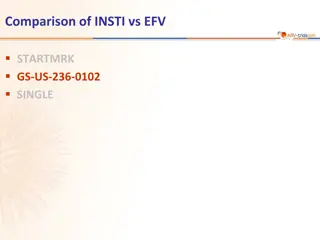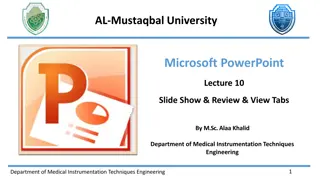
Effective Intervention for Central Line Infections in ICU
This proposal addresses the issue of central line acquired infections in the intensive care unit (ICU) by focusing on proper maintenance strategies such as cleaning the site, changing dressings, and ensuring hygiene levels. Evidence-based literature supports the need for these interventions to reduce infection rates, mortality, and healthcare costs associated with central line infections.
Download Presentation

Please find below an Image/Link to download the presentation.
The content on the website is provided AS IS for your information and personal use only. It may not be sold, licensed, or shared on other websites without obtaining consent from the author. If you encounter any issues during the download, it is possible that the publisher has removed the file from their server.
You are allowed to download the files provided on this website for personal or commercial use, subject to the condition that they are used lawfully. All files are the property of their respective owners.
The content on the website is provided AS IS for your information and personal use only. It may not be sold, licensed, or shared on other websites without obtaining consent from the author.
E N D
Presentation Transcript
Change Proposal JOBBER ROMERO CASTILLO GRAND CANYON UNIVERSITY: NRS-493-0502 OCTOBER 16, 2020
The Intervention The problem which is being addressed in this case is about the occurrence of central line acquired infections for the patients who have been admitted to the intensive care unit (ICU). The proposed intervention to deal with the mentioned problem will involve the proper maintenance of a central line by the nurses. Notably, the nurse in the acute care setting will have to clean the site in order to avoid the possibility of an infection occurring. Additionally, nurses will be required to change the dressings when soiled as a way of maintaining high levels of hygiene. Lastly, the nurse will need to change the dressings on the central line once in a while to ensure there are no infections.
Evidence based Literature There is a lot of literature which has delved into the issue of the central line acquired infections which occur in the acute care setting For starters, Atilla et al. (2016) go into detail about how infections gain entry to the bloodstream. As well, the authors delve into the way that a care bundle can be used to deal with the issue of central line acquired infections. Mishra et al. (2016) go into detail about the severity associated with the occurrence of central line acquired infections. In particular, the authors delve into the risk factors, incidences, and cases of mortality.
Evidence based Literature Additionally, Patel et al. (2017) look into the strategies which can be utilized to lower the occurrence of infections in the ICU. Also, Huerta, Nelson, Stewart, & Rice (2018) delves into the relationship between the occurrence of central line acquired infections and an increase in the mortality rates. In that way, it helps in creating urgency in addressing the issue of central line acquired infections in the ICU. Moreover, there is evidence-based literature that creates an association between the occurrence of central line acquired infections and an increase in the length of the hospital stays among patients who have been admitted to the ICU (Cohen, Gesser-Edelsburg, Singhal, Benenson, & Moses, 2019).
Evidence based Literature Patel (2018) dwells on why there is a need to maintain high levels of hygiene when handling the central line. For example, there is a need to ensure that the insertion area is cleaned thoroughly to ensure that no infection occurs. Moreover, Lutwick et al. (2019) assert that there will be a need for training for the nurses involved in implementing evidence-based interventions. That will reduce the occurrence of errors in the implementation process. Lastly, Baier et al. (2020) look into the manner that the occurrence of central line acquired infections will be associated with increased readmission rates and costs of healthcare.
Objectives The primary objective of the change proposal will be to ensure there is a reduction in the occurrence of central line acquired infections for the patients. As well, evidence-based intervention and change proposal will be aimed at reducing the mortality rates which are associated with the occurrence of the infections. Additionally, the change proposal has the objective of reducing the time that is spent by patients who are admitted to the (ICU). Moreover, the change proposal will have the objective of helping the healthcare professionals make alterations in how they take care of patients in the acute care setting.
Resources Needed In the implementation of the change proposal, there are different resources which are needed For starters, there is a need for training healthcare professionals on the manner to handle the central lines in accordance with the proposed intervention. As well, there is a need for an increase in the number of healthcare professionals given that there will be a huge workload. Hence, there will be a need to hire nurses. Furthermore, it is vital to have material such as the dressings which will be used in covering the central line once it has been inserted. Lastly, it is essential to have administrative support in the implementation of evidence-based interventions.
Anticipated Measurable Outcomes. In implementing the change proposal, there are different measurable outcomes which will be used in determining its effectiveness. First, is there a change in the occurrence of the central line acquired infections? In case there is a decrease, it will imply that the evidence-based intervention is effective. Secondly, it will be to assess if there is a decrease in the mortality rates associated with the occurrence of central line acquired infections. A fall in the mortality rates implies that the interventions are working. Thirdly, it is to evaluate if there is a decrease in the length of hospital stays associated with the occurrence of infections. A decrease will mean that the interventions are effective.
Anticipated Measurable Outcomes. Fourthly, it is assessing if there is a fall in the costs associated with the treatment of patients in the acute care setting. A decrease in the costs will mean that the change proposal will have achieved the desired outcome. Fifthly, it is evaluating if there is a change in the number of hospital readmission associated with the occurrence of central line acquired infections. A fall in the readmission rates will imply that the evidence-based intervention is effective. The lasts measurable outcome is in terms of the overall patient satisfaction with the services which are offered in the healthcare organization.
The Evaluation Process The efforts to evaluate the change proposal will occur procedurally. Firstly, it will be the identification of the dimensions which will be used in the evaluation process Some of the dimensions will include costs, length of hospital stays, readmission rates, and the level of patient satisfaction. Secondly, there will be the identification of different stakeholders who will be involved in the evaluation. Some of the stakeholders will include healthcare professionals and hospital administration.
The Evaluation Process Thirdly, there will be the identification of the methods which will be used in the evaluation process. Fourthly, it is determining the resources which will be needed to carry out the evaluation successfully. For example, will the nurses and other healthcare professionals need to be trained in the manner they will handle the entire process? Fifthly, it is to create a plan which will be utilized in implementing the results of the evaluation. There is a need to ensure that the results of the evaluation process are implemented in the practice setting to create improvements.
References Atilla, A., Do anay, Z., elik, H. K., Tomak, L., G nal, ., & K l , S. S. (2016). Central line-associated bloodstream infections in the intensive care unit: Importance of the care bundle. Korean Journal of Anesthesiology, 69(6), 599-603. doi:10.4097/kjae.2016.69.6.599 Baier, C., Linke, L., Eder, M., Schwab, F., Chaberny, I. F., Vonberg, R., & Ebadi, E. (2020). Incidence, risk factors and healthcare costs of central line-associated nosocomial bloodstream infections in hematologic and oncologic patients. PLOS ONE, 15(1), 1-11. doi:10.1371/journal.pone.0227772 Cohen, R., Gesser-Edelsburg, A., Singhal, A., Benenson, S., & Moses, A. E. (2019). Deconstruction of central line insertion guidelines based on the positive deviance approach Reducing gaps between guidelines and implementation: A qualitative ethnographic research. PLOS ONE, 14(9), 1-15. doi:10.1371/journal.pone.0222608 Huerta, L. E., Nelson, G. E., Stewart, T. G., & Rice, T. W. (2018). Factors associated with recurrence and mortality in central line-associated bloodstream infections: A retrospective cohort study. Critical Care, 22(266), 1-8. doi:10.1186/s13054-018-2206-7 Lutwick, L., Al-Maani, A. S., Mehtar, S., Memish, Z., Rosenthal, V. D., Dramowski, A., Bearman, G. (2019). Managing and preventing vascular catheter infections: A position paper of the international society for infectious diseases. International Journal of Infectious Diseases, 84, 22-29. doi:10.1016/j.ijid.2019.04.014 Mishra, S., Misra, R., Azim, A., Baronia, A., Prasad, K., Dhole, T., Poddar, B. (2016). Incidence, risk factors and associated mortality of central line-associated bloodstream infections at an intensive care unit in northern India. International Journal for Quality in Health Care, 29(1), 63-67 doi:10.1093/intqhc/mzw144 Patel, P. K. (2018). Prevention of Central Line Associated Bloodstream Infections. Journal of Clinical Outcomes Management, 25(6), 273-277. Patel, P. K., Gupta, A., Vaughn, V. M., Mann, J. D., Ameling, J. M., & Meddings, J. (2017). Review of strategies to reduce central line-associated bloodstream infection (CLABSI) and catheter-associated urinary tract infection (CAUTI) in adult ICUs. Journal of Hospital Medicine, 13(2), 105-106. doi:10.12788/jhm.2856






















